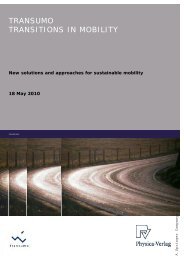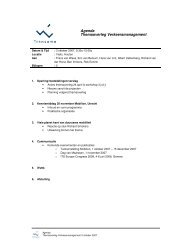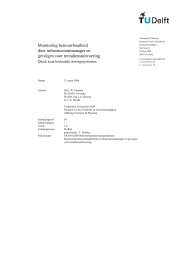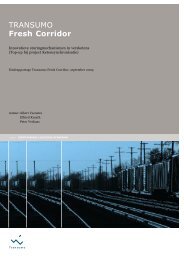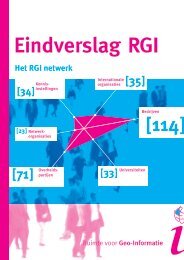Casestudie Breakdown prediction Contell PILOT - Transumo
Casestudie Breakdown prediction Contell PILOT - Transumo
Casestudie Breakdown prediction Contell PILOT - Transumo
You also want an ePaper? Increase the reach of your titles
YUMPU automatically turns print PDFs into web optimized ePapers that Google loves.
w ( t + 1) = w ( t)<br />
+ α ⋅(<br />
d ( t)<br />
− y ( t)<br />
⋅ x ( t)<br />
= w ( t)<br />
+ α ⋅δ<br />
( t)<br />
⋅ x ( t)<br />
ij<br />
ij<br />
i<br />
i<br />
j<br />
ij<br />
i<br />
j<br />
with<br />
w<br />
α > 0 = Learning rate<br />
δ = Error<br />
x = Given input<br />
d<br />
i<br />
i<br />
i<br />
= Weighting of connection<br />
= Aimed result<br />
y = Calculated Output<br />
i<br />
ij<br />
i = 1, K,<br />
n<br />
from n<br />
j<br />
to n<br />
i<br />
Formula 5-22: The Delta Rule<br />
Unsupervised learning has to be used, if only the question of data analysis but not<br />
the result is available. The general idea is again to train the network with sample<br />
patterns. But this time, the network has to find and evaluate structures itself. A<br />
needed requirement is redundancy within the input vector. The more redundancy, the<br />
better the training results because it allows the identification of noise and<br />
disturbances. ([Heuer97], p. 18; [Hagen97], p. 19)<br />
Most unsupervised approaches use Hebb learning. This principle is adopted from the<br />
human brain because the weighting of the connection between two active neurons<br />
increases. Hebb defined that the weighting is proportional to the product of the two<br />
neurons’ outputs. Formula 5-23 summarizes this approach. ([Hagen97], p. 20)<br />
w ( t + 1) = w ( t)<br />
+ α ⋅ y ( t)<br />
⋅ y ( t)<br />
ij<br />
ij<br />
i<br />
j<br />
with<br />
w<br />
= Weighting of connection<br />
α > 0 = Learning rate<br />
y = Calculated Output<br />
i<br />
ij<br />
from n<br />
j<br />
to n<br />
i<br />
Formula 5-23: Hebb Learning Rule<br />
5.9.3 Non-Applicability of Artificial Neural Networks to Current Datasets<br />
Although many different specific artificial neural networks do exist, they are always<br />
based on either supervised or unsupervised learning methods. An application of an<br />
unsupervised artificial neural network to currently obtained temperature data is not<br />
possible, because each input vector would only contain a time, a temperature and<br />
78



